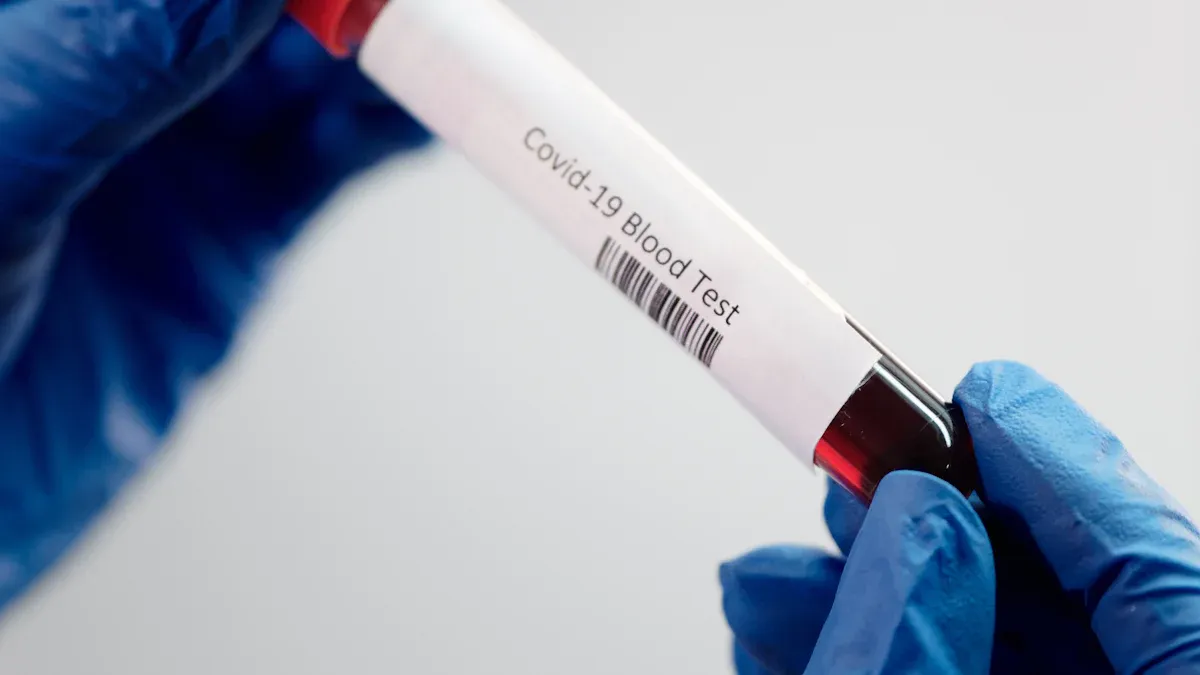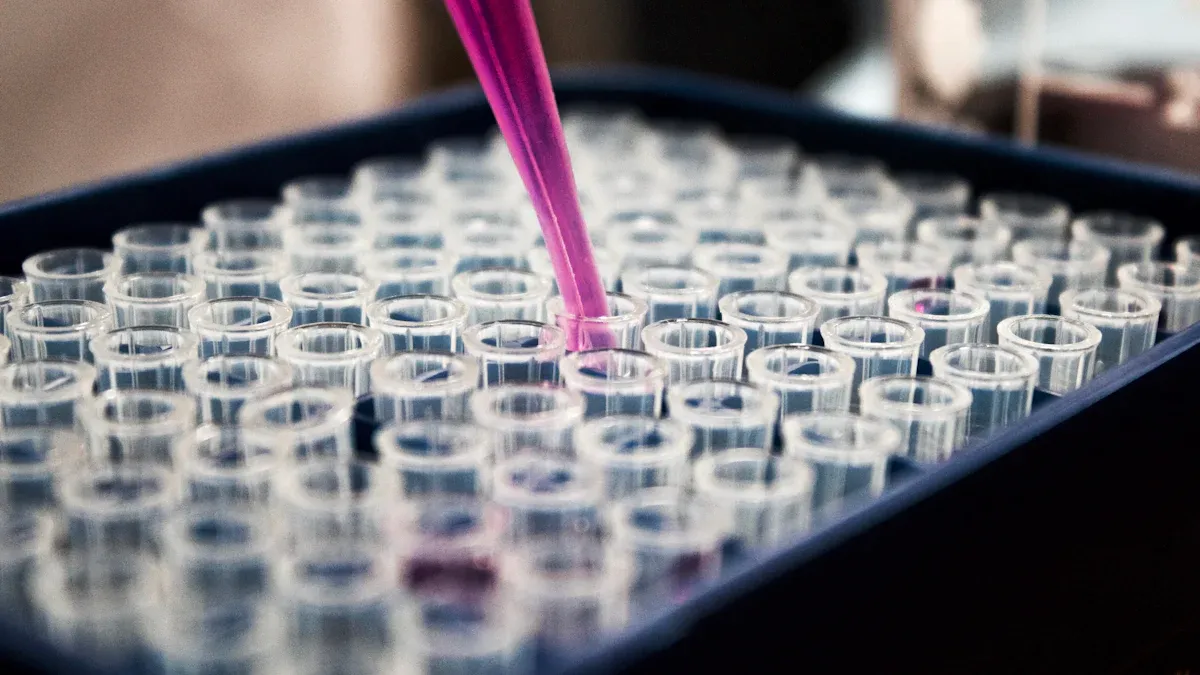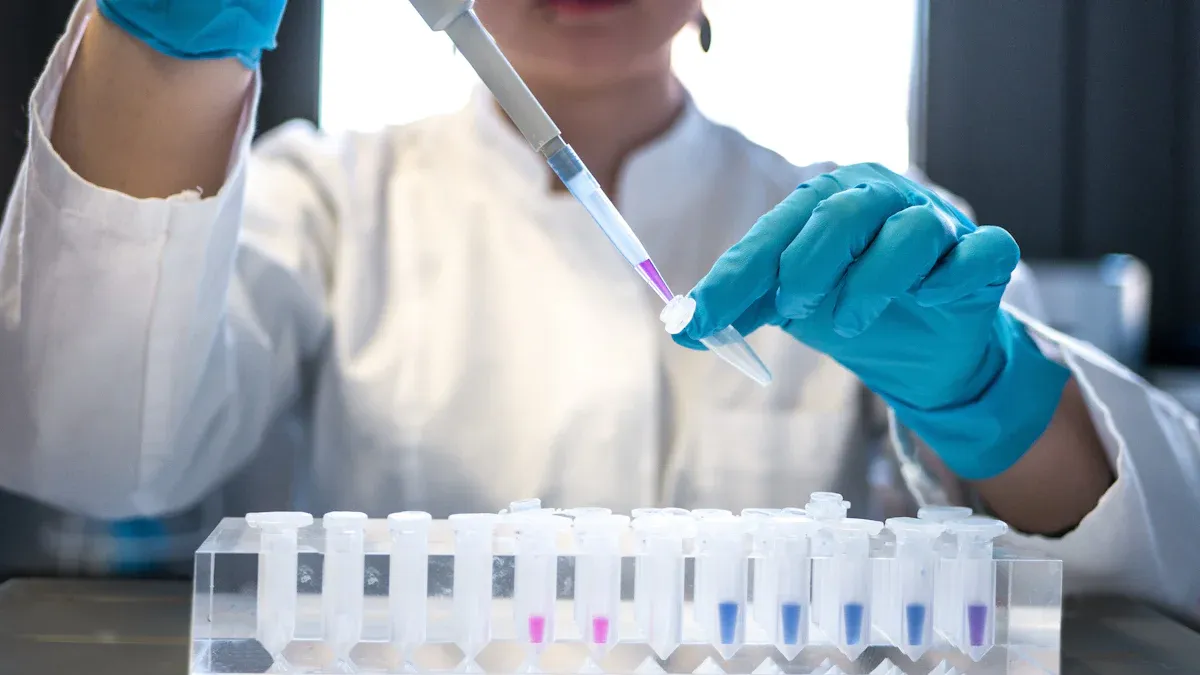A Guide to Manufacturing Nitinol Tubing for Medical Diagnostics

Nitinol tubing for diagnostic equipment plays a vital role in advancing medical devices. Its unique superelastic and shape-memory properties make it indispensable for modern diagnostic tools. The manufacturing process demands exacting standards to meet stringent medical requirements.
Precision is critical, as outer diameter tolerances for nitinol tubing must adhere to strict limits:
For OD ≤ 0.3 mm: ±0.005 mm
For 0.3 ≤ OD ≤ 0.5 mm: ±0.007 mm
For 0.5 ≤ OD ≤ 1.5 mm: ±0.015 mm
Manufacturers must also comply with ISO 13485 certification, ensuring safety and reliability in medical devices. Such adherence not only supports global demand, where 68% of nitinol serves medical applications, but also avoids costly FDA non-compliance issues.
The high precision required underscores nitinol tubing's importance in delivering accurate diagnostic results and maintaining patient safety.
Key Takeaways
Nitinol tubing is important for medical tools because it bends easily and remembers shapes, making devices work better.
Makers must follow strict size rules and get ISO 13485 approval to keep medical tools safe and reliable.
Checking quality is key during production, with careful tests to ensure the tubing is accurate and works well.
Heating steps like shape setting and softening improve how nitinol tubing works, so it fits medical tool needs.
Surface finishing, like electropolishing, makes it safer for the body and stops rust, perfect for medical use.
Material Preparation for Nitinol Tubing
Melting and Alloying of Nitinol
The first step in nitinol tubing manufacturing involves melting and alloying the raw materials. Nitinol, a nickel-titanium alloy, requires precise control of its composition to achieve the desired superelastic and shape-memory properties. Manufacturers typically use vacuum induction melting (VIM) or vacuum arc remelting (VAR) to create a high-purity alloy. These methods minimize contamination and ensure uniformity in the material's structure.
The melting process combines nickel and titanium in specific ratios, usually near 55% nickel and 45% titanium by weight. This ratio is critical for achieving the unique properties of nitinol. Even slight deviations can affect the alloy's performance in medical applications. Advanced techniques, such as double or triple melting, further enhance the material's homogeneity and reduce inclusions that could compromise the tubing's fatigue life.
Studies comparing different manufacturing techniques highlight the importance of precise alloying. For example:
TM-1 tubing demonstrates fatigue lives two to three times greater than TM-2 tubing for standard VIM-VAR grade nitinol.
This finding underscores the significant relationship between the alloying process and the durability of nitinol tubing used in medical diagnostics.
Ingot Formation and Initial Testing
After alloying, the molten nitinol is cast into ingots. These ingots serve as the starting point for further processing into tubing. The ingot formation process must maintain consistent parameters to ensure the material's quality. Any structural imperfections, such as inclusions or voids, can lead to localized stress points, reducing the tubing's fatigue resistance.
Initial testing of the ingots plays a crucial role in nitinol tubing manufacturing. Quality control measures assess the ingots for structural integrity and chemical composition. Statistical outcomes from these tests validate the alloying process and guide subsequent steps. For instance:
Findings | Implications |
|---|---|
Fatigue damages attributed to local load peaks at structural imperfections | Indicates the importance of controlling inclusions during ingot production to enhance fatigue properties of nitinol tubing. |
Constant processing parameters from ingot to final size | Ensures consistency in testing and validates the quality of the alloying process. |
20 to 30% cold work level yields greatest mean cycles to failure | Suggests optimal processing conditions for enhancing fatigue lifetime in nitinol tubing. |
These insights emphasize the need for meticulous attention during ingot formation. By controlling inclusions and maintaining consistent processing parameters, manufacturers can produce high-quality nitinol tubing that meets the rigorous demands of medical diagnostics.
Forming Processes in Nitinol Tubing Manufacturing

Gun Drilling for Tubing Formation
Gun drilling is a critical step in the manufacturing of nitinol tubing. This process involves creating a hollow cavity in a solid nitinol rod, which is later drawn into a tube. Gun drills, typically hollow and up to 4 feet long, are used to achieve the precise hole required for hollow tube formation. The process demands meticulous control over the inner diameter and tolerances, which is achieved using dies and a mandrel.
While gun drilling is essential for converting the rod into tubing, it significantly reduces material yield. A substantial amount of nitinol is removed during this step, and the material cannot be reclaimed. This highlights the importance of optimizing the process to minimize waste while maintaining the quality of the tubing.
Seamless Tubing Drawing Techniques
After gun drilling, the hollow nitinol rod undergoes seamless tubing drawing. This technique involves pulling the hollow rod through a series of dies to achieve the desired dimensions. The process ensures that the tubing maintains uniformity in both its inner and outer diameters.
Seamless drawing is particularly important for medical applications, where precision is paramount. The technique eliminates the risk of seams or welds, which could compromise the tubing's structural integrity. By maintaining consistent dimensions, seamless drawing enhances the performance and reliability of nitinol tubing in diagnostic equipment.
Dimensional Adjustments and Cold-Working
Dimensional adjustments and cold-working play a vital role in refining the properties of nitinol tubing. During die drawing operations, controlling the ratio of the outer diameter to wall thickness is crucial for achieving the desired dimensions. Despite these adjustments, studies show that the microstructural characteristics of nitinol remain largely unchanged, ensuring the material's integrity.
Cold-working also contributes to the healing of the material's matrix, which is essential for enhancing fatigue life. This step ensures that the tubing can withstand the rigorous demands of medical diagnostics without compromising performance. By carefully managing these processes, manufacturers produce high-quality nitinol tubing that meets stringent medical standards.
Heat Treatment in the Manufacturing Process
Heat treatment plays a pivotal role in the manufacturing of nitinol tubing, as it directly influences the material's superelasticity, shape memory, and mechanical properties. This step ensures that the tubing meets the stringent requirements of medical devices while maintaining biocompatibility and corrosion resistance.
Shape Setting for Diagnostic Equipment
Shape setting is a critical heat treatment process that allows nitinol tubing to retain specific configurations, such as coils or helical shapes, essential for diagnostic equipment. Manufacturers achieve this by heating the tubing to a precise temperature and holding it for a specific duration. For instance, a shape-setting temperature of 500 °C for 30 minutes ensures optimal mechanical properties and proper helical shape formation.
The process involves clamping the tubing into a desired shape using specialized fixtures. Once heated, the tubing undergoes a transformation that locks the shape into its memory. This property is particularly beneficial for medical devices like stents, where the tubing must expand to fit within blood vessels. The transformation temperature, such as an austenite finish temperature (Af) of 23.5 °C, ensures the tubing functions effectively in the human body.
Process Parameter | Value | Notes |
|---|---|---|
Shape-setting Temperature | 500 °C | Optimal for mechanical properties |
Shape-setting Duration | 30 min | Ensures proper helical shape formation |
Transformation Temperature | Af = 23.5 °C | Suitable for stenting applications |
Surface Finishing | Unaltered | Confirmed by microscopy analysis |
This meticulous process guarantees that nitinol tubing meets the high standards required for medical diagnostics, ensuring both functionality and long-term biocompatibility.
Annealing for Superelasticity
Annealing is another essential heat treatment step that enhances the superelasticity of nitinol tubing. This process involves heating the tubing to a controlled temperature and then cooling it at a specific rate. Annealing relieves internal stresses within the material, allowing it to exhibit its unique ability to return to its original shape after deformation.
Superelasticity is vital for medical devices that require flexibility and durability, such as guidewires and catheters. During annealing, the tubing undergoes structural changes that optimize its performance. Differential scanning calorimetry (DSC) curves demonstrate how heat treatment alters the material's properties, while tensile tests validate its strength and stretching ability.
Key Tests for Superelasticity:
Tensile tests assess the tubing's strength and elongation capacity.
Bend Free Recovery (BFR) tests evaluate the tubing's ability to return to its original shape after bending.
Non-destructive tests, such as X-ray and ultrasound, ensure the tubing's structural integrity.
By carefully controlling the annealing process, manufacturers enhance the superelasticity of nitinol tubing, ensuring it meets the rigorous demands of medical applications.
Optimizing Mechanical Properties
The final stage of heat treatment focuses on optimizing the mechanical properties of nitinol tubing. This step ensures the tubing achieves the perfect balance between strength, flexibility, and fatigue resistance. Precipitate formation during heat treatment plays a crucial role in strengthening the material's structure.
Evidence Type | Description |
|---|---|
DSC Curves | Show how heat treatment changes the material. |
Austenite Finish Temp. | Helps find the best heat treatment for shape memory. |
Precipitate Formation | Explains how heat affects material structure and strength. |
Manufacturers use precise heat treatment parameters to achieve these properties. For example, maintaining consistent processing conditions during heat treatment ensures uniformity in the tubing's performance. This consistency is critical for medical devices, where even minor deviations can compromise safety and effectiveness.
The combination of shape setting, annealing, and mechanical property optimization ensures that nitinol tubing meets the highest standards of biocompatibility and corrosion resistance. These processes enable the tubing to perform reliably in medical diagnostics, advancing the capabilities of modern healthcare.
Surface Finishing of Nitinol Tubing

Polishing for Medical-Grade Standards
Polishing plays a vital role in the manufacturing of nitinol tubing, especially for medical applications. This process enhances the tubing's surface quality, ensuring it meets stringent medical-grade standards. Manufacturers use various techniques to achieve optimal results. Wire brushing provides a quick method to remove surface oxidation, though it offers limited depth. Abrasive polishing effectively removes heavier oxide layers, delivering a smoother finish but requiring more resources. Electropolishing stands out as the most advanced technique, improving biocompatibility and corrosion resistance.
Electropolishing smooths out microcracks and reduces surface roughness, which minimizes the risk of device failure. It also removes contaminants, enhancing the tubing's overall biocompatibility. These improvements make electropolishing ideal for nitinol tubing used in medical diagnostics, where precision and reliability are paramount.
Cleaning and Impurity Removal
Cleaning is an essential step in the surface finishing process for nitinol tubing. It ensures the removal of impurities that could compromise the tubing's performance or safety. Manufacturers employ specialized cleaning methods to eliminate contaminants, such as residual oxides and machining oils, from the tubing's surface.
Effective cleaning enhances the tubing's corrosion resistance and biocompatibility. By removing impurities, the process reduces the likelihood of surface imperfections that could lead to device failure. This step is particularly important for medical applications, where even minor defects can impact patient safety.
Achieving a Smooth Surface Finish
Achieving a smooth surface finish is critical for nitinol tubing used in medical diagnostics. A smooth finish reduces surface roughness, improving the tubing's performance and longevity. Techniques like electropolishing not only enhance the tubing's appearance but also optimize its mechanical properties.
A smooth surface finish minimizes the risk of microcracks and other imperfections that could weaken the tubing. It also improves the tubing's corrosion resistance, ensuring it can withstand the harsh conditions of medical environments. By prioritizing surface finishing, manufacturers produce high-quality nitinol tubing that meets the rigorous demands of medical diagnostics.
Quality Control in Nitinol Tubing Manufacturing
Quality control is a cornerstone of nitinol tubing manufacturing, ensuring that the final product meets the rigorous demands of medical devices. From dimensional accuracy to functional property verification, every step of the process is meticulously monitored to guarantee reliability and biocompatibility.
Dimensional Accuracy Testing
Dimensional accuracy is critical for nitinol tubing, particularly for cardiovascular devices where precision directly impacts performance. Manufacturers like AccuPath implement rigorous inspection protocols to ensure consistency across production batches. Key parameters include:
Outer diameter, typically 1.61 mm for capillary tubing.
Wall thickness, ranging from 0.1 mm to 15 mm.
Length, which can extend up to 6000 mm.
Regular inspections verify the uniformity of wall thickness and the stability of outer diameters. Material composition testing further ensures the correct nickel-titanium ratio, which is vital for maintaining the tubing's superelasticity and shape memory. AccuPath’s advanced quality control systems set a benchmark in the industry, delivering tubing that meets the exacting standards of cardiovascular devices.
Functional Property Verification
Nitinol tubing must retain its unique functional properties throughout the manufacturing process. Manufacturers conduct stress and strain tests to simulate real-world conditions, ensuring the tubing performs reliably under pressure. These tests confirm that the shape memory effect is properly locked in, a critical feature for cardiovascular and other medical devices.
AccuPath employs cutting-edge technology to maintain strict quality control during production. This ensures that the tubing’s superelasticity and fatigue resistance remain intact, even in demanding applications. By adhering to these rigorous standards, AccuPath consistently delivers high-performance nitinol tubing for medical diagnostics.
Compliance with Medical Diagnostic Standards
Compliance with medical diagnostic standards is non-negotiable in nitinol tubing manufacturing. Manufacturers must meet ISO 13485 certification requirements, which guarantee the safety and reliability of medical devices. AccuPath’s commitment to quality control ensures that its tubing not only meets but often exceeds these standards.
By prioritizing biocompatibility and corrosion resistance, AccuPath produces tubing that performs flawlessly in cardiovascular devices. This dedication to excellence has positioned AccuPath as a trusted partner in the medical industry, advancing the capabilities of diagnostic equipment worldwide.
AccuPath’s expertise in nitinol tubing manufacturing ensures that every product meets the highest standards of quality and performance, making it a leader in the field of cardiovascular and medical diagnostics.
Manufacturing nitinol tubing involves a series of precise steps, from alloying and ingot formation to forming, heat treatment, and surface finishing. Each stage ensures the tubing achieves the required mechanical properties, biocompatibility, and corrosion resistance for medical diagnostics. Precision in these processes is essential to meet strict medical standards and deliver reliable performance.
Quality control plays a pivotal role in producing medical-grade nitinol tubing. Dimensional accuracy testing, functional property verification, and compliance with ISO 13485 ensure the tubing meets the demands of diagnostic equipment. Manufacturers also face challenges such as rising compliance costs and skilled labor deficits, which impact production timelines and costs.
Evidence Type | Details |
|---|---|
Price Fluctuations | Nickel prices surged by over 250% in early 2022 due to geopolitical tensions. |
Lead Time Extensions | 55% of Nitinol manufacturers face lead time extensions of 8–12 weeks due to equipment bottlenecks. |
Compliance Costs | A leading European manufacturer reported a 22% increase in compliance costs in 2023. |
Market Growth Rate | Nitinol tubing demand is growing at 9% annually. |
Skilled Labor Deficit | The US Bureau of Labor Statistics projects a 17% deficit in qualified personnel by 2025. |
CAGR for Market Growth | The market is expected to grow at a CAGR of 7.8% from 2023 to 2030. |
Nitinol tubing has revolutionized diagnostic equipment by enabling advanced designs and improved functionality. Its unique properties, such as superelasticity and shape memory, allow for innovative applications in cardiovascular devices and beyond. As demand grows at an annual rate of 9%, precision manufacturing continues to drive advancements in medical diagnostics, ensuring better patient outcomes and global healthcare improvements.
FAQ
What makes nitinol tubing ideal for medical diagnostics?
Nitinol tubing offers unique properties like superelasticity and shape memory. These features allow it to adapt to complex medical applications, such as cardiovascular devices. Its biocompatibility and corrosion resistance further enhance its suitability for diagnostic equipment.
How is dimensional accuracy maintained during manufacturing?
Manufacturers use advanced inspection tools to monitor outer diameter, wall thickness, and length. Regular testing ensures uniformity across batches. Dimensional accuracy is critical for medical devices, where even minor deviations can impact performance.
Why is surface finishing important for nitinol tubing?
Surface finishing improves the tubing’s biocompatibility and corrosion resistance. Techniques like electropolishing remove impurities and smooth out microcracks. This process ensures the tubing meets stringent medical-grade standards and performs reliably in diagnostic applications.
What challenges do manufacturers face in producing nitinol tubing?
Manufacturers encounter rising compliance costs, skilled labor shortages, and material price fluctuations. These factors extend production timelines and increase costs. Despite these challenges, demand for nitinol tubing continues to grow annually.
How does heat treatment enhance nitinol tubing properties?
Heat treatment optimizes mechanical properties like superelasticity and fatigue resistance. Processes such as annealing relieve internal stresses, while shape setting locks specific configurations. These steps ensure the tubing meets the demands of medical diagnostics.
See Also
Understanding The Manufacturing Process Of Nitinol Tubing
Investigating The Uses Of Nitinol Tubing In Healthcare
Nitinol Tubing's Impact On The Future Of Medical Devices
Nitinol Tubing's Contribution To Progress In Medical Technology
The Importance Of Nitinol Tubing In Modern Medical Applications

